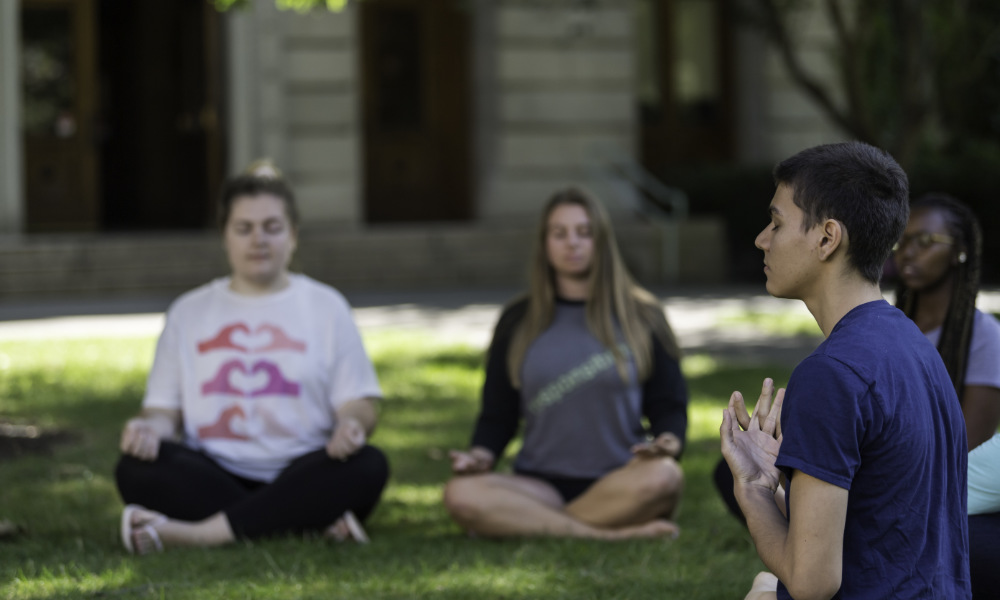Rochester expert sheds light on the challenges faced by college students recovering from trauma and on the role of trigger warnings.
College students with symptoms of post-traumatic stress disorder are present in significant numbers on American campuses, as suggested in a 2018 study.
The gateway to PTSD symptoms is exposure to a life-threatening event, extreme physical harm or sexual violence, either personally or as a witness. Not everyone who experiences a traumatic event develops PTSD. But research shows that roughly two-thirds of incoming undergraduate students have reported exposure—and nearly 10 percent of those develop post-traumatic symptoms.
Tricia Shalka, an assistant professor in the Warner School of Education at the University of Rochester, studies the impact of trauma on students’ developmental outcomes. What distinguishes trauma from other kinds of negative experiences, she says, is that trauma entails ripple effects. For people who are traumatized, “there’s some kind of lasting adverse consequence because of what you’ve experienced.”
Those consequences can play out in ways that significantly diminish the quality of a student’s college education. “In so many ways, some of these experiences of trauma can be working against some of the basic goals we have for students,” says Shalka.
The post-trauma ‘shadow space’
Shalka’s recent project is a qualitative study of students and recent graduates who experienced their trauma during their time at college. Her goals in the study, published in The Review of Higher Education, were to find out how the trauma played out in their daily lives, and what that meant for their experience of college.
She was struck by a theme: for these students, the campus itself had become “a kind of battleground.” In walking from a class to a dining hall, from a car to the library, “survivors navigated campus environments through the lens of threats to safety and integrity,” she wrote. Post-trauma, her participants described their felt experience of campus spaces as utterly transformed.
Shalka brought an array of literature addressing spaces and identities—from architectural theory on liminal space to the concept of the borderland articulated in 1987 by the queer Chicana feminist theorist Gloria Anzaldúa—to bear on the experiences her participants described. As a result, she came up with an analogy of her own: survivors occupied a “shadow space”—a separate space that was neither the same nor entirely different from the space occupied by their peers.
She likens the shadow space to what one observes when the sun moves across the sky on any given day—to a scene, for example, in her backyard. “In the morning, everything is illuminated,” she says. “The trees, the bushes, the fence.” As the afternoon arrives and progresses, a shadow begins to drape across those same objects. By evening, the entire scene is transformed. The objects are the same, but the space looks and feels different.
While the study’s participants occupy the same physical environment as their peers, they face the task of navigating it through this shadow space. There, they work hard to account for what-ifs, to find places of safety and escape, and often to conceal their inner turmoil and the complicated maneuvers they’ve devised on its account.
One participant—a Muslim woman who, after multiple aggressions aimed at her, was approached in a parking lot and had her hijab ripped from her head—found that she was unable to be in class unless she could find a seat with her back to a wall. Another participant, who was homeless, made elaborate negotiations to avoid visibility on campus.
Over and over again, Shalka heard her participants use the word “exhausting.”
Designing a community of care

Shalka’s focus on the spatial dimension of trauma is significant because most research views traumatic experience through a temporal lens: the traumatic event occurs, and then post-traumatic symptoms and repercussions unfold at various life stages, intensifying or abating over time.
Illuminating the spatial dimension of traumatic experience invites college and university leaders to think about ways design might alleviate some of the burden on trauma survivors.
Here, Shalka briefly points to tools institutions have already been using. For example, colleges and universities conduct space audits and hire architects and interior designers to create spaces that facilitate collaboration, or that foster community. Attention to the experiences of students like the ones in her study would likely lead to improvements for everyone, she suggests.
Shalka says her research also indicates the need to reframe the issue of campus safety—to think beyond “blue lights and security presence” and toward greater emphasis on building what she calls “a community of care.” That’s a community that fosters strong relationships among students, and trust between students and faculty and between students and staff.
Yet as the efforts of colleges and universities to build such communities have become politicized, Shalka says, succinctly: “This is less about coddling, as I sometimes hear it, than about, how do we empower an entire community to be functioning at their best and to feel productive and connected and like they belong?”
Q&A: A closer look at trauma and trigger warnings
What is triggering?
Shalka: Triggering is any time that somebody who has undergone trauma experiences something that brings them back to whatever that trauma was. It could be that they see something, they hear something, they read something, or they smell something. At that moment, it’s the sense that we are back reliving it; our bodies may experience overwhelming sensations that may even feel the same as when the original trauma happened.
How does triggering manifest on college campuses?
Shalka: A good example came from one of the students in my study who described how she was in the library, reading a textbook, when she came to a place in the text that mentioned sexual assault. At that moment, she’s feeling overwhelming sensations and she’s crying, feeling like she was reliving her own experience of sexual assault. She described how she went into a kind of tunnel vision where she couldn’t see anything else but had to get up and try and run to the bathroom to process everything in private. She actually nearly ran into another student, literally, because she was so removed from everything else happening around her. These are intense sensations in the body that send the message, ‘I’m not safe; I’m not OK.’
When a student is triggered in the middle of a class, they’re not engaging with the material anymore, or the professor, or the people around them.
What is a trigger warning?
Shalka: A trigger warning is basically an opportunity where we can give someone some advanced sense of what’s about to happen, or what’s about to come up that could be triggering to them. For example, if there’s a text that deals with sexual assault, we provide that information in advance, so the person knows, before they read it, what’s coming. That gives the student an opportunity to prepare and do what they need to do to engage with the material—or to decide not to engage with the material.
Why has there been so much controversy over the use of trigger warnings in college classrooms?
Shalka: There’s sometimes a sense that trigger warnings amount to coddling. I think that’s based on a misunderstanding about what the real purpose of a trigger warning is.
I view the real purpose of a trigger warning as that of providing someone with some sense of control in that they get to make a decision about what they want to do and how they want to proceed. It doesn’t mean necessarily that we’re saying, ‘Oh, you don’t ever have to attend class; you don’t ever have to do the readings.’ It’s more an acknowledgement of, maybe this person wants to do this particular reading in a space where they feel really safe, or when they can have a supportive friend nearby. It gives them the possibility of having the distressing reaction that they might have on their own terms.
For example, one of my study participants was caught off guard when a movie trailer about sexual assault was shown at the start of a class. That student shared that they became so overwhelmed and distressed that they ran out of the classroom and ended up in a fetal position in the hallway with everybody watching as they passed by. A head’s up to that student about what would be shown that day would have given them options. Maybe the student would have arrived a bit late to class. Maybe the student would have zoned out while the clip was shown and fiddled on their phone. Maybe the student would have mentally prepared and used other coping skills but watched. The point is that offering the heads up would have provided choices that may not have resulted in the really terrible experience that instead happened for that student.
Another reason for the controversy is that trigger warnings have become connected to conversations around free speech. But I don’t think the intent is to keep people away from diverse perspectives as much as it is to recognize that if we can anticipate something might be triggering, that we try and do our best to minimize that kind of harm. The kind of harm that students who have undergone trauma experience is a very different kind of harm than being exposed to a viewpoint that you disagree with.
There was a study written up in the Chronicle of Higher Education which purportedly concluded that trigger warnings don’t work and aren’t effective. What’s your response?
Shalka: Without getting into too many specifics, one of the claims was that trigger warnings increase what’s called anticipatory anxiety—in this case, the anxiety a student would experience between the time of the warning and when the student engages with the material. But if you’ve experienced trauma and are going to be confronted with something that’s triggering, you’re going to experience anxiety. Trigger warnings give survivors space and choice about where they want to have an anxiety response. It’s the difference between reading something at home and having an anxiety experience in front of all your peers in a class.
Another claim that’s mentioned in this article is that trigger warnings are ineffective because they don’t improve a student’s mental health or PTSD symptoms. Again, I think this may be where we’re confusing the actual purpose of a trigger warning. Trigger warnings aren’t about doing the work to help survivors heal from trauma that may be best suited to clinical settings or other healing modalities. Instead, we’re trying to say with a trigger warning that we can anticipate that there are certain things that may produce an entirely overwhelming response for a student survivor of trauma, and we’re saying that we want to give you a heads-up to encounter that response in a way that feels most safe and supportive to you.
Trauma responses aren’t something we wave a magic wand on and make go away—we’re trying to offer trauma survivors some humanity in saying that we care about and respect you enough to give you agency and choice about how and where you want to have these difficult reactions.
Let’s say an educator wants to put trigger warnings into practice. How can an instructor anticipate what might be triggering for a student?
Shalka: Often people think of trigger warnings as these impersonal, blanket statements that a professor makes to an entire class before a reading assignment, for example. That can certainly be useful and is a good start. But the work of trigger warnings doesn’t always have to take that form.
One of the basic principles of trauma-informed teaching and learning is about paying attention to relationships. Relationships are so fundamental to healing and recuperation. The degree to which we get to know our students will help us to better anticipate if something might be triggering, but it is also an element of helping to create an increased sense of safety for students in academic environments. It doesn’t mean we need to get all the details of our students’ lives; but as we build a relationship over time, we have a better sense of the student as well as a greater capacity to establish environments that are rich for their learning.
But we also need to recognize that we’re never going to be able to anticipate everything that could be triggering to someone, even if we know what their trauma is. Some triggers can be very literal, as in a student who has been sexually assaulted reading about sexual assault. But some can be much more abstract, such as smelling a particular barbecue sauce, where the smokiness of it reminds someone of the smoke from a fire at the scene of a car accident.
The important point is trying to look for the obvious places where there could be potential harm and then supporting and being empathetic with students, helping them through to the degree we can.
Read more
 Amid student mental health challenges, Rochester broadens outreach and access
Amid student mental health challenges, Rochester broadens outreach and access
Peer counseling, mindful practice, therapy dogs, 24/7 care—supporting the well-being and mental health of college students at Rochester takes many forms.
 University-wide coalition on student mental health and wellness is formed
University-wide coalition on student mental health and wellness is formed
The new group will assess the current state of student mental health at Rochester and make recommendations to improve student well-being.
 Free speech and trigger warnings
Free speech and trigger warnings
On college campuses, where safe spaces and free inquiry often coexist, do trigger warnings protect students or hinder free speech?





